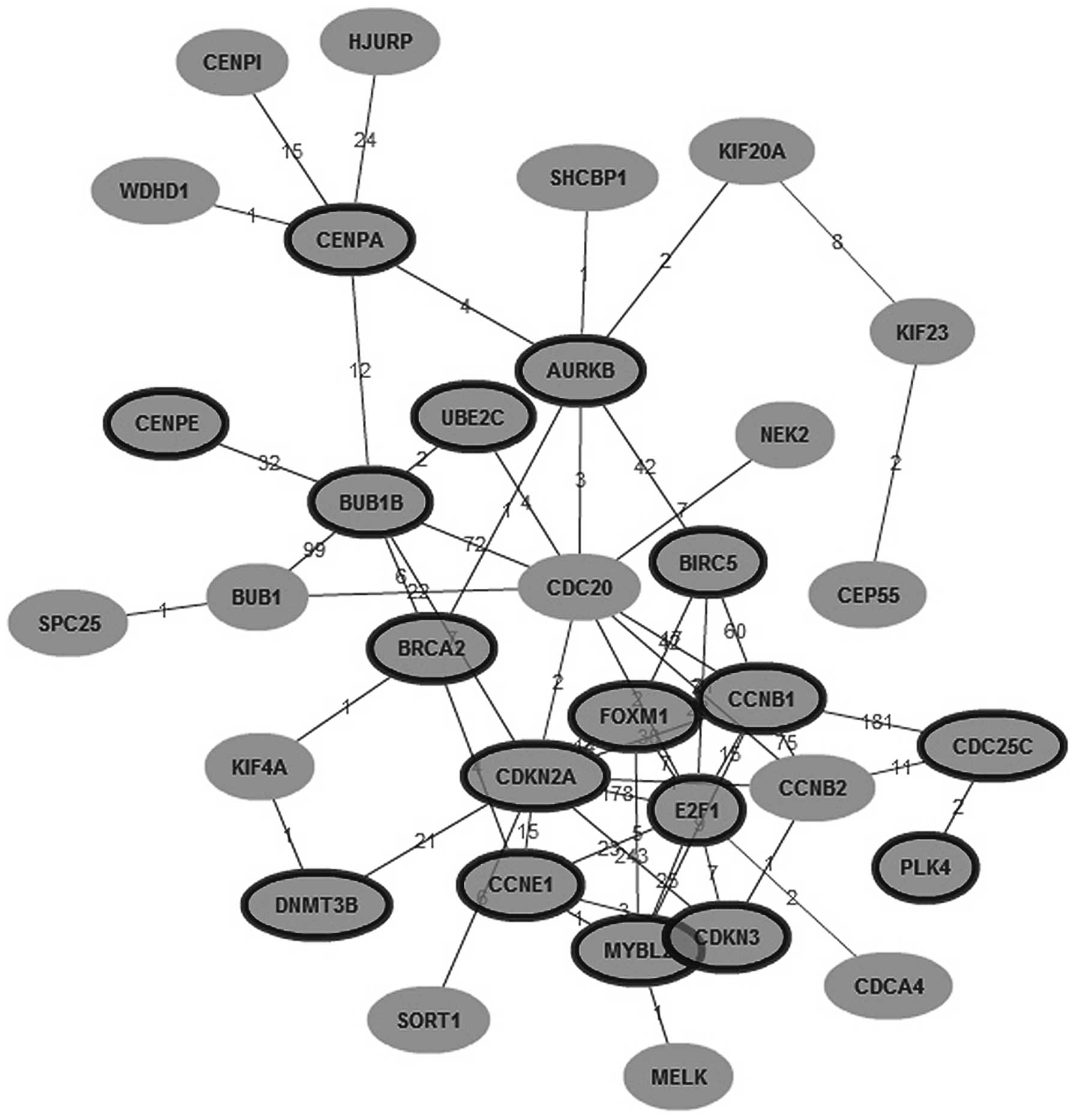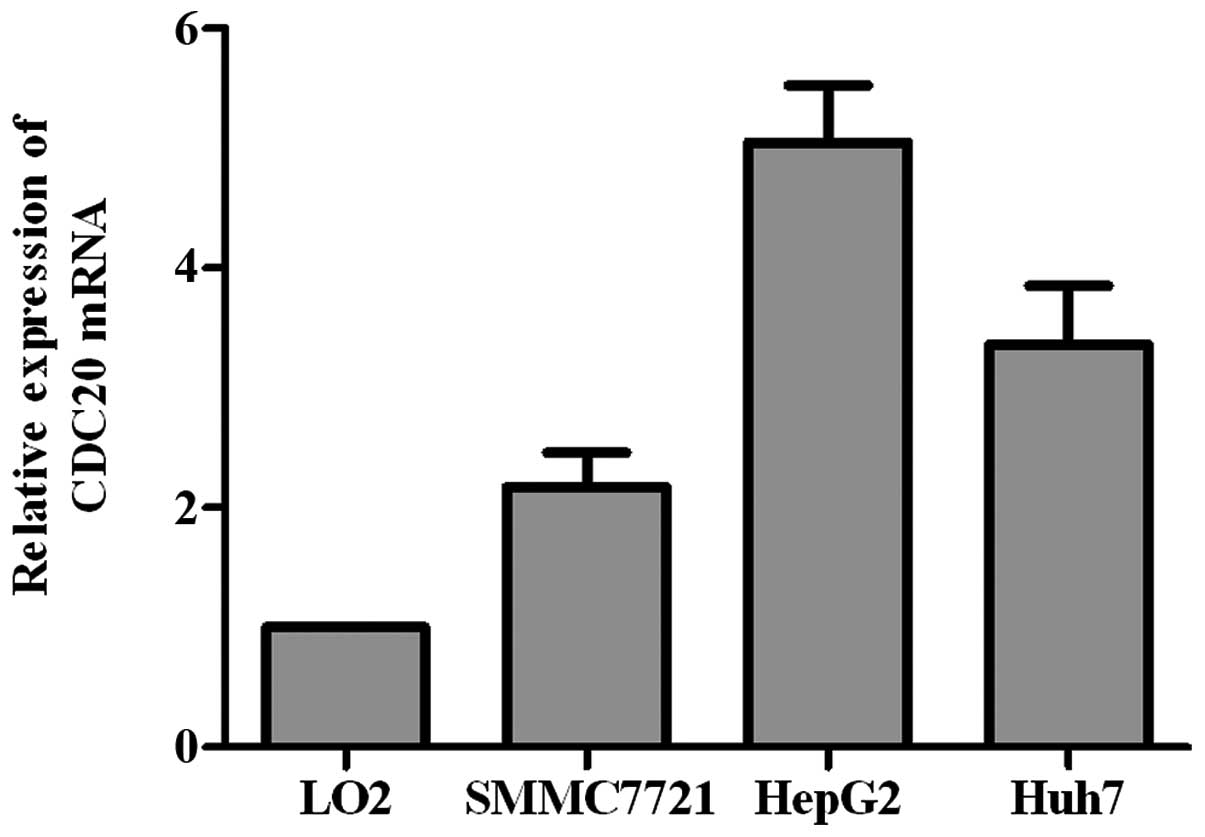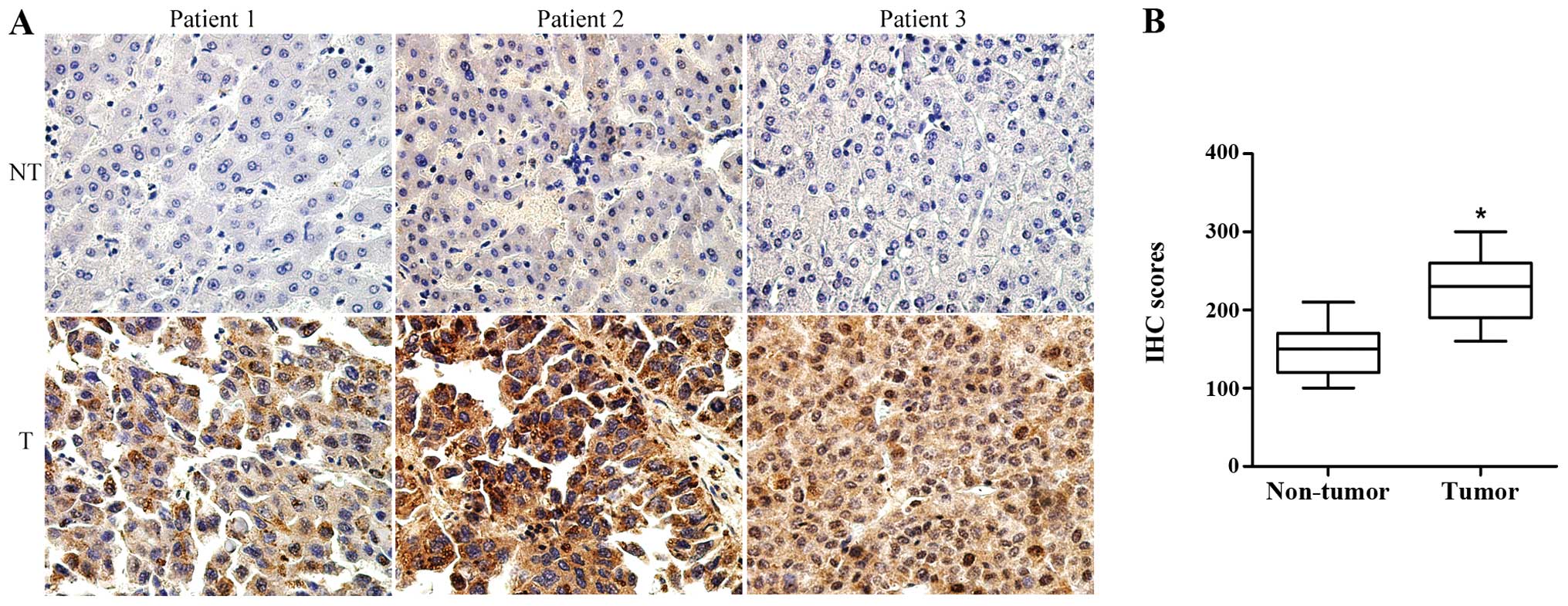|
1
|
Parkin DM: Global cancer statistics in the
year 2000. Lancet Oncol. 2:533–543. 2001.PubMed/NCBI
|
|
2
|
El-Serag HB and Rudolph KL: Hepatocellular
carcinoma: epidemiology and molecular carcinogenesis.
Gastroenterology. 132:2557–2576. 2007. View Article : Google Scholar : PubMed/NCBI
|
|
3
|
Jemal A, Bray F, Center MM, Ferlay J, Ward
E and Forman D: Global cancer statistics. CA Cancer J Clin.
61:69–90. 2011. View Article : Google Scholar
|
|
4
|
Severi T, van Malenstein H, Verslype C and
van Pelt JF: Tumor initiation and progression in hepatocellular
carcinoma: risk factors, classification, and therapeutic targets.
Acta Pharmacol Sin. 31:1409–1420. 2010. View Article : Google Scholar : PubMed/NCBI
|
|
5
|
Michielsen P and Ho E: Viral hepatitis B
and hepatocellular carcinoma. Acta Gastroenterol Belg. 74:4–8.
2011.
|
|
6
|
McGivern DR and Lemon SM: Virus-specific
mechanisms of carcinogenesis in hepatitis C virus associated liver
cancer. Oncogene. 30:1969–1983. 2011. View Article : Google Scholar : PubMed/NCBI
|
|
7
|
Fung TK and Poon RY: A roller coaster ride
with the mitotic cyclins. Semin Cell Dev Biol. 16:335–342. 2005.
View Article : Google Scholar : PubMed/NCBI
|
|
8
|
Weinstein J, Jacobsen FW, Hsu-Chen J, Wu T
and Baum LG: A novel mammalian protein, p55CDC, present in dividing
cells is associated with protein kinase activity and has homology
to the Saccharomyces cerevisiae cell division cycle proteins Cdc20
and Cdc4. Mol Cell Biol. 14:3350–3363. 1994.
|
|
9
|
Peters JM: Cell biology: the checkpoint
brake relieved. Nature. 446:868–869. 2007. View Article : Google Scholar : PubMed/NCBI
|
|
10
|
Fang G, Yu H and Kirschner MW: Direct
binding of CDC20 protein family members activates the
anaphase-promoting complex in mitosis and G1. Mol Cell. 2:163–171.
1998. View Article : Google Scholar : PubMed/NCBI
|
|
11
|
Cho HJ, Lee EH, Han SH, et al: Degradation
of human RAP80 is cell cycle regulated by Cdc20 and Cdh1 ubiquitin
ligases. Mol Cancer Res. 10:615–625. 2012. View Article : Google Scholar : PubMed/NCBI
|
|
12
|
Kidokoro T, Tanikawa C, Furukawa Y,
Katagiri T, Nakamura Y and Matsuda K: CDC20, a potential cancer
therapeutic target, is negatively regulated by p53. Oncogene.
27:1562–1571. 2008. View Article : Google Scholar : PubMed/NCBI
|
|
13
|
Chang DZ, Ma Y, Ji B, et al: Increased
CDC20 expression is associated with pancreatic ductal
adenocarcinoma differentiation and progression. J Hematol Oncol.
5:152012. View Article : Google Scholar : PubMed/NCBI
|
|
14
|
Kim JM, Sohn HY, Yoon SY, et al:
Identification of gastric cancer-related genes using a cDNA
microarray containing novel expressed sequence tags expressed in
gastric cancer cells. Clin Cancer Res. 11:473–482. 2005.PubMed/NCBI
|
|
15
|
Espinosa AM, Alfaro A, Roman-Basaure E, et
al: Mitosis is a source of potential markers for screening and
survival and therapeutic targets in cervical cancer. PloS One.
8:e559752013.PubMed/NCBI
|
|
16
|
Ouellet V, Guyot MC, Le Page C, et al:
Tissue array analysis of expression microarray candidates
identifies markers associated with tumor grade and outcome in
serous epithelial ovarian cancer. Int J Cancer. 119:599–607. 2006.
View Article : Google Scholar
|
|
17
|
Roessler S, Jia HL, Budhu A, et al: A
unique metastasis gene signature enables prediction of tumor
relapse in early-stage hepatocellular carcinoma patients. Cancer
Res. 70:10202–10212. 2010. View Article : Google Scholar
|
|
18
|
Irizarry RA, Hobbs B, Collin F, et al:
Exploration, normalization, and summaries of high density
oligonucleotide array probe level data. Biostatistics. 4:249–264.
2003. View Article : Google Scholar
|
|
19
|
Dai M, Wang P, Boyd AD, et al: Evolving
gene/transcript definitions significantly alter the interpretation
of GeneChip data. Nucleic Acids Res. 33:e1752005. View Article : Google Scholar : PubMed/NCBI
|
|
20
|
Tusher VG, Tibshirani R and Chu G:
Significance analysis of microarrays applied to the ionizing
radiation response. Proc Natl Acad Sci USA. 98:5116–5121. 2001.
View Article : Google Scholar : PubMed/NCBI
|
|
21
|
Huang ZX, Tian HY, Hu ZF, Zhou YB, Zhao J
and Yao KT: GenCLiP: a software program for clustering gene lists
by literature profiling and constructing gene co-occurrence
networks related to custom keywords. BMC Bioinformatics. 9:3082008.
View Article : Google Scholar : PubMed/NCBI
|
|
22
|
Adhikary S and Eilers M: Transcriptional
regulation and transformation by Myc proteins. Nat Rev Mol Cell
Biol. 6:635–645. 2005. View
Article : Google Scholar : PubMed/NCBI
|
|
23
|
Detre S, Saclani Jotti G and Dowsett M: A
‘quickscore’ method for immunohistochemical semiquantitation:
validation for oestrogen receptor in breast carcinomas. J Clin
Pathol. 48:876–878. 1995.
|
|
24
|
Früh MPM: EGFR IHC score for selection of
cetuximab treatment: Ready for clinical practice? Transl Lung
Cancer Res. 1:145–146. 2012.
|
|
25
|
Hwang LH, Lau LF, Smith DL, et al: Budding
yeast Cdc20: a target of the spindle checkpoint. Science.
279:1041–1044. 1998. View Article : Google Scholar : PubMed/NCBI
|
|
26
|
Kops GJ, Weaver BA and Cleveland DW: On
the road to cancer: aneuploidy and the mitotic checkpoint. Nat Rev
Cancer. 5:773–785. 2005. View
Article : Google Scholar : PubMed/NCBI
|
|
27
|
Mondal G, Sengupta S, Panda CK, Gollin SM,
Saunders WS and Roychoudhury S: Overexpression of Cdc20 leads to
impairment of the spindle assembly checkpoint and aneuploidization
in oral cancer. Carcinogenesis. 28:81–92. 2007. View Article : Google Scholar : PubMed/NCBI
|
|
28
|
Moura IM, Delgado ML, Silva PM, et al:
High CDC20 expression is associated with poor prognosis in oral
squamous cell carcinoma. J Oral Pathol Med. 43:225–231. 2013.
View Article : Google Scholar : PubMed/NCBI
|
|
29
|
Wu WJ, Hu KS, Wang DS, et al: CDC20
overexpression predicts a poor prognosis for patients with
colorectal cancer. J Transl Med. 11:1422013. View Article : Google Scholar : PubMed/NCBI
|
|
30
|
Yeong FM, Lim HH, Padmashree CG and Surana
U: Exit from mitosis in budding yeast: biphasic inactivation of the
Cdc28-Clb2 mitotic kinase and the role of Cdc20. Mol Cell.
5:501–511. 2000. View Article : Google Scholar : PubMed/NCBI
|
|
31
|
Huang HC, Shi J, Orth JD and Mitchison TJ:
Evidence that mitotic exit is a better cancer therapeutic target
than spindle assembly. Cancer Cell. 16:347–358. 2009. View Article : Google Scholar : PubMed/NCBI
|
|
32
|
Wang Z, Wan L, Zhong J, et al: Cdc20: a
potential novel therapeutic target for cancer treatment. Curr Pharm
Des. 19:3210–3214. 2013. View Article : Google Scholar : PubMed/NCBI
|
|
33
|
Bunz F, Dutriaux A, Lengauer C, et al:
Requirement for p53 and p21 to sustain G2 arrest after DNA damage.
Science. 282:1497–1501. 1998. View Article : Google Scholar : PubMed/NCBI
|
|
34
|
Wells J, Boyd KE, Fry CJ, Bartley SM and
Farnham PJ: Target gene specificity of E2F and pocket protein
family members in living cells. Mol Cell Biol. 20:5797–5807. 2000.
View Article : Google Scholar
|




















